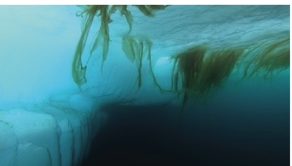In a landmark collaborative effort, Kirstin Schulz, a research associate at the University of Texas at Austin's Oden Institute for Computational Engineering and Sciences, has worked within a team of 45 international researchers to unveil insights into the thin meltwater layers in Arctic sea ice.
Arctic summers witness melting of snow and sea ice, contributing substantial low-salinity meltwater to the surface ocean. Schulz emphasized the significance of the work, stating, "The observations of these meltwater layers are very patchy, and the layers themselves are not very well studied."
The paper, entitled "Thin and transient meltwater layers and false bottoms in the Arctic sea ice pack—Recent insights on these historically overlooked features," not only provides a comprehensive review of existing literature but also integrates recent findings from the Multidisciplinary drifting Observatory for the Study of Arctic Climate (MOSAiC) campaign.
The MOSAiC campaign, a multidisciplinary research initiative, involved a scientific expedition to the Arctic from 2019 to 2020. The aim was to enhance our understanding of the Arctic climate system by conducting comprehensive measurements and observations. MOSAiC provided a unique opportunity for researchers like Schulz to collect data co-located around meltwater dynamics, shedding light on a previously underexplored aspect of the Arctic environment.
Meltwater layers, often less than a meter thick, have proven challenging to detect with traditional methods, but their impact on the Arctic system is profound. From influencing ice melt to affecting the exchange of gasses between ocean and atmosphere, these layers play a crucial role in the delicate Arctic ecosystem.
The Oden Institute's Computational Research in Ice and Ocean Systems (CRIOS) group, where Schulz is a part, applies advanced computational methods to better understand the role of the global ocean, sea ice, and polar ice sheets in the climate system. Their work involves building computational models of the global sea-ice system.
"This publication is a good thing that could eventually contribute to improving computational models of the Arctic system," Schulz stated.
The distribution of meltwater layers, occurring every spring and summer, is expected to undergo changes, according to Schulz. With a more seasonal ice coverage in the Arctic Ocean, local variations in melt may influence the distribution patterns of these layers, presenting challenges and opportunities for researchers and modelers alike.
The 45 authors of this scientific publication were of the Woods Hole Oceanographic Institution, Ecole Polytechnique Fédérale de Lausanne, University of Grenoble Alpes, University of California San Diego, University of East Anglia, Alfred-Wegener-Institut, University of Gothenburg, Norwegian Polar Institute, University of Warwick, University of York, Bigelow Laboratory for Ocean Sciences, University of Colorado, Boulder, NOAA Physical Sciences Laboratory, University of Helsinki, University of Groningen, Institute of Marine Research, Colorado State University, University of Rhode Island, Université de Liège, University of Bergen, Universität Hamburg, Arctic University of Norway, Université Libre de Bruxelles, Hokkaido University, Norwegian University of Science and Technology, University of Plymouth, University of Texas at Austin, University of Plymouth, University of Gothenburg, University of Washington, Seattle, and Third Institute of Oceanography.
